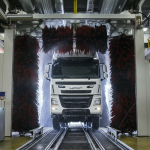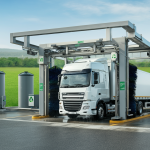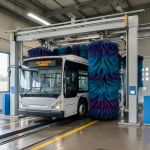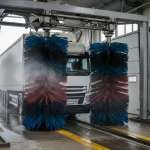Keeping large vehicles such as trucks and buses clean is integral to their maintenance and operation. Whether you’re managing a trucking fleet or a transit service, understanding the nuances of truck and bus washing systems can help you make informed decisions about the right maintenance solutions for your needs. Although they seemingly serve different sectors, truck and bus washes share similarities in their goals, challenges, and in some cases, equipment. However, significant differences arise in design, cleaning processes, and operational requirements that cater specifically to the vehicles’ unique characteristics.
This post dives into the distinctions and overlaps between truck and bus washes, explores the scenarios where each is applied, and helps businesses determine the ideal wash system for their fleet.
The Similarities Between Truck and Bus Wash Systems
A Shared Goal of Cleanliness and Maintenance
At their core, both truck and bus wash systems aim to maintain vehicles’ appearances and functionality. Dirt, grime, and contaminants can accumulate on vehicle surfaces, causing aesthetic degradation and even operational inefficiencies. Ensuring cleanliness also protects fleet reputation, as dirty vehicles can send negative signals about the quality of service or company professionalism.
Maintenance of Health and Safety Standards
Both trucks and buses must comply with health and safety regulations, especially when dealing with industries such as food delivery (for trucks) or public transportation (for buses). Proper cleaning routines ensure hygiene, whether it’s addressing road salt residue that can corrode surfaces or removing harmful bacteria from heavily trafficked interiors.
Equipment Style and Washing Mechanisms
Truck and bus washing systems frequently incorporate similar equipment such as brushes, high-pressure jets, and detergents. Whether an automated drive-through setup or a mobile washing unit, the underlying principles of dirt removal through mechanical action or pressure washing are consistent. Some systems even use water recycling technology, making them more environmentally friendly.
Common Challenges Faced
Both washing systems encounter challenges such as dealing with intricate surfaces (mirrors, grills, air-conditioning units) or heavy dirt contamination due to road or environmental conditions. Sustainability is also a shared priority, as operators seek to minimize water and chemical usage to reduce costs and environmental impact.
Key Differences Between Truck and Bus Washes
Design and Dimensions
One of the most critical differences lies in how truck and bus wash systems are designed. Trucks, especially long-haul models, come in diverse configurations, including tractor units and various-shaped trailers. Bus washes, on the other hand, cater to vehicles with consistent shapes, like city buses or coaches. Truck washes need flexibility to accommodate rigs, tankers, or flatbeds of various sizes, while bus washes can focus on a more uniform set of dimensions.
Example Scenario:
A truck wash system may employ movable gantries to reach all parts of a long semi-trailer, while a bus wash system might have stationary brushes optimized for the height of a standard transit bus.
Cleaning Complexity and Process
The cleaning processes also differ substantially. Trucks often accumulate oil, grease, and industrial contaminants, especially those operating in construction or shipping industries. These require stronger detergents and scrubbing mechanisms. Buses, on the other hand, prioritize passenger-related hygiene, involving careful cleaning of interior surfaces, handles, and seats. The exterior focus for buses leans more towards removing dirt and grime affecting visibility, such as on windows or mirrors.
Example Scenario:
A logistics company might require a truck wash system capable of pressure-cleaning caked-on mud from tires and undercarriages. A bus operator, however, might be more concerned with ensuring that the windows and interiors are spotless for passenger comfort.
Washing Speed and Fleet Workflow
Bus washes are often designed for quicker turnaround times due to higher fleet demand and the need to maintain public transportation schedules. A typical bus wash system allows vehicles to pass through in quick succession, often without requiring parts to be removed. Conversely, truck washes may take longer since certain configurations—like refrigerated trailers—need specialized attention.
Example Scenario:
A public transit agency might prioritize speed, running buses through a washing station at the end of their routes. Meanwhile, a trucking company that hauls perishable goods needs extended cleaning cycles to sanitize refrigerator units between shipments.
Investment and Operational Costs
Thanks to their relatively straightforward applications, bus wash systems often involve lower capital investment and operational costs compared to truck washes. Since truck washes handle more varied contaminants and configurations, equipment durability and adaptability often command a higher price tag.
Choosing the Right Wash System for Your Fleet
When deciding between truck and bus wash systems, businesses must analyze their fleet composition and operational priorities. Here are some tips:
- Assess Your Fleet’s Configuration:
If your fleet includes diverse vehicle types or long trailers, a truck wash system with flexible cleaning capabilities is essential. For uniform vehicle dimensions like standard transit or school buses, a specialized bus wash will suffice.
- Consider Cleaning Requirements:
Determine whether your focus is on heavy-duty dirt removal, interior hygiene, or a mix of both. For example, refrigerated trucks may need advanced sanitation, whereas bus fleets emphasize maintaining spotless interiors for passengers.
- Evaluate Workflow and Speed Needs:
If your fleet operates under tight schedules, opt for a wash system with rapid turnaround capabilities. Many bus washes are built for high-volume efficiency, while truck washes often require adaptable designs that can handle variable workloads.
- Think Sustainability:
Both truck and bus operators can benefit from choosing wash systems designed with water-recycling technology or eco-friendly detergents to meet environmental goals while managing costs effectively.
The Importance of Clean Fleet Vehicles
Whether for buses or trucks, cleanliness extends beyond appearance—it plays a significant role in functionality, safety, and business reputation. Clean vehicles run more reliably, offer extended lifespans, and create better brand impressions. For trucks, staying clean ensures regulatory compliance and better aerodynamics. For buses, it directly impacts passenger comfort and confidence in public transportation.
Final Thoughts
Both truck and bus wash systems fulfill vital roles in maintaining fleet vehicles, but their designs and processes vary significantly to meet the specific needs of these vehicles. By understanding the key differences and similarities, businesses can better select or design systems that optimize cleanliness, operational efficiency, and costs. Ultimately, whether you’re running a logistics company or managing a transit fleet, investing in the right washing system ensures your vehicles always look and perform at their best.




